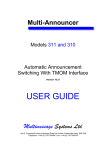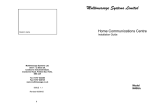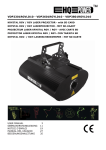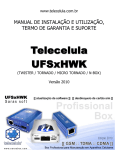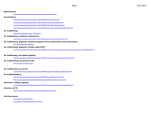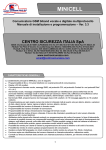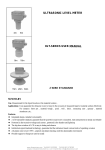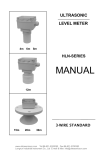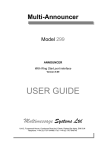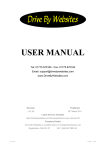Download 311 & 310 - Multimessage Systems Ltd
Transcript
Multi-Announcer Models 311 and 310 One Digit Auto-Attendant Version 12.04 USER GUIDE Multimessage Systems Ltd Units 1 & 2 Cranborne Road Ind. Estate, Potters Bar Herts, EN6 3JH Telephone: ++44 (0) 1707 644480 Fax: ++44 (0) 1707 646745 One Digit Auto-Attendand Version 12.04 page 1 INTRODUCTION TO YOUR MULTI-ANNOUNCER ................................................................. 4 APPROVAL INFORMATION ........................................................................................................ 4 SYSTEM CAPACITY: ......................................................................................................................... 4 INSTALLATION ............................................................................................................................. 5 CHOOSING A SUITABLE SITE............................................................................................................ 5 UNPACKING THE SYSTEM ................................................................................................................ 5 CONNECTION AND CONDITIONS FOR USE ......................................................................................... 5 CONNECTIONS ON FRONT AND REAR PANELS - M311....................................................................... 6 CONNECTIONS ON FRONT AND REAR PANELS - M310....................................................................... 7 CONNECTIONS ON FRONT AND REAR PANELS - M310L....................................................................... 8 SAFETY INFORMATION ..................................................................................................................... 9 Fitting a plug.............................................................................................................................. 9 INSTALLATION PROCEDURE............................................................................................................ 10 READ THIS FIRST ....................................................................................................................... 11 MENUS ......................................................................................................................................... 11 FUNCTION DISPLAYS ..................................................................................................................... 11 SETTING THE TIME AND DATE .............................................................................................. 12 RECORD ANNOUNCEMENTS ................................................................................................... 12 RECORD TRANSFER TO AGENT ............................................................................................. 13 EXAMPLE OF RECORDINGS TO GIVE AUTO-ATTENDANT FUNCTIONS .................................................. 14 OTHER DISPLAYS DURING RECORD ................................................................................................ 15 THE EXTERNAL INPUT SOCKET............................................................................................. 15 ERASING ANNOUNCEMENTS................................................................................................... 16 PLAYING ANNOUNCEMENTS .................................................................................................. 16 ENABLE LINES ............................................................................................................................ 17 INHIBIT LINES............................................................................................................................. 17 DROP LINES ................................................................................................................................. 17 ZERO CALLS................................................................................................................................ 17 ASSIGN ANNOUNCEMENT........................................................................................................ 18 TOTAL COUNT OF CALLS RECEIVED ................................................................................... 19 VERSION ....................................................................................................................................... 19 DIRECTORY OF LINES .............................................................................................................. 20 TO RESET LINE CALLS COUNTER FOR SELECTED LINE ........................................................................ 20 REVIEW OR CHANGE TRANSFER OVERRIDE TIME .......................................................... 21 REVIEW OR CHANGE PORT TYPE ......................................................................................... 22 One Digit Auto-Attendand Version 12.04 page 2 REVIEW OR ENABLE/DISABLE ‘BEEP’ AT END OF PLAY................................................. 23 REVIEW OR ENABLE/DISABLE DIAL TONE CALL CLEARING ........................................ 23 One Digit Auto-Attendand Version 12.04 page 3 Introduction To Your Multi-Announcer Read this section to get an overview of how your Multimessage Multi-Announcer works. This section also contains some important information about conditions for installing and connecting the unit There are two models in the Multimessage Multi-Announcer range: ♦ the Model 311, which is fitted in a one-unit-high case and may be equipped to answer two, four or six telephone lines ♦ the Model 310, which is fitted in a three/five-unit-high case and may be equipped to answer up to 15/31 telephone lines The instructions in this User Guide apply to both models, except for the installation instructions these apply to the Model 311 only; qualified engineers must install the Model 310. Your Multimessage Multi-Announcer gives you the ability to play up to 99 pre-recorded announcements to your callers. Each caller hears the relevant announcement from the beginning. Each port is assigned ten announcements from which your callers may select by pressing digits 1..9 on their phone keypad. Pressing 0 repeats the initial greeting announcement. These 10 announcements may be of any combination selected from the 99 available. The announcements may be recorded so that they contain the control signals to instruct your PABX to transfer callers to another extension or groups of extensions. They can be a combination of speech followed by the control signals. To record announcements and set up the system, you use an ordinary tone-dialling telephone; and you can modify the announcements and settings while the system continues to answer calls. You can also use recordings made on an external device such as a cassette recorder. Approval Information This apparatus has been approved for use with the following facilities: ♦ ♦ ♦ ♦ ♦ ♦ ♦ ♦ ♦ Auto-answering; Auto-clearing; All callers hear the announcement from the beginning; Call counters for each port and for system total; Announcements can be modified while the machine continues to answer calls; Controlled from simple telephone with tone dialling; Mains powered from 240 V AC, 100mA, 24W peak; Battery backup - running for three hours; 45 hours memory retention (optional extended memory for Model 310 -running for ten hours: 135 hours memory retention). Solid-state storage of announcements. System Capacity: ♦ ♦ ♦ ♦ ♦ ♦ ♦ ♦ ♦ 3.5 to 220 minutes on Model 310. 3.5 to 14 minutes on Model 311. 2 to 31 ports on Model 310. 2,4 or 6 ports on Model 311. Up to 99 announcements. Any ten announcements may be assigned to any port. Any port can be enabled, disabled or forced to drop the call in progress. Ports can be assigned to groups of lines. Connection of external tape recorder for audio input and output ( -10dBm peak maximum input ). Any other usage will invalidate the approval of the apparatus if as a result it ceases to comply with the standards against which approval was granted. One Digit Auto-Attendand Version 12.04 page 4 Installation These installation instructions apply to Multi-Announcer Model 311 only. Model 310 must be installed by engineers authorised by Multimessage Systems Ltd. If you are installing a Model 311 Multi-Announcer please make sure you follow the instructions carefully and in the order given. Choosing A Suitable Site The unit should be installed on a level, solid surface, where: ♦ the mains lead will reach a 240 V AC switched mains socket, preferably with a guard fitted so that it cannot be accidentally switched off. ♦ the telephone line cords will reach your telephone line sockets. ♦ there is a minimum of background noise, so that you can record your announcements satisfactorily. ♦ you can easily see the display (preferably at head height). ♦ the unit is away from direct sunlight or heating appliances ♦ air can circulate around the unit (allow at least 10 mm clearance all round) ♦ the temperature is maintained between -10°C and 40°C. ♦ the unit is away from water or corrosive chemicals, particularly salt spray. Unpacking The System When you unpack the system from its box, you will find: ♦ the Model 311/310 Multi-Announcer. ♦ a mains lead with fitted plug (if you need to change the plug, refer to the 'Safety Information' page. ♦ the battery fuse. ♦ telephone line cords (the quantity depends on the number of lines you purchased)/cable with krone termination strips. ♦ a telephone handset. ♦ this User Guide. Connection And Conditions For Use Multimessage Multi-Announcer Models 310 and 311 are approved for: connection to two or more direct exchange lines from the public switched telephone network; two or more extension lines on an approved call routing apparatus (PBX or key system). These line may use either DTMF4 (tone) or loop-disconnect (pulse) signalling. The apparatus is not suitable for connection as an extension to a payphone, neither to a shared-service (party) line or a 1+1 carrier system. The Multimessage Multi-Announcer Model 311 is connected to the public network using the modular plug and socket system. The Model 310 is hard-wired, and must be installed by an authorised engineer One Digit Auto-Attendand Version 12.04 page 5 Connections On Front And Rear Panels - M311 Push the plug just below the shutter and use it to raise the shutter Connect to your sockets Ports 2..8 Telephone line sockets 2 Battery fuse holder 3 4 TEL No. (+44) 01707 644480 FAX No. 7 8 Display THIS FUSE MUST BE REMOVED WHEN NOT IN SERVICE Serial number Port indicators (on when port is busy) Mains input socket Socket for connecting telephone Socket for connecting audio input from tape recorder EXTERNAL AUDIO INPUT ACTIVE LINES 2 3 1 LOCAL Port 1 Local Handset indicator (on when port is busy) MAINS FUSE 250 mA (T) SERIAL No: 3281 DESIGNED AND MANUFACTURED IN THE U.K Software configuration label (on under side) 250 V 50-60 hZ (+44) 01707 646745 MODEL No: 311 6 BATTERY FUSE 5 AMP MULTIMESSAGE SYSTEMS LTD TELEPHONE LINES 5 Mains fuse 4 5 6 7 MAINS LOCAL HANDSET Mains power indicator light One Digit Auto-Attendand Version 12.04 EXTERNAL AUDIO OUTPUT MULTIMESSAGE Systems Ltd M311 Socket for connecting audio input to tape page 6 Connections On Front And Rear Panels - M310 M310 Krone Strip Connection Details Krone strip 1 2 3 4 5 6 7 8 9 10 Announcer port 2 3 4 5 6 7 8 9 10 11 Krone strip 1 2 3 4 5 6 7 8 9 10 Announcer port 12 13 14 15 16 NU NU NU NU NU NU = Not Used Mains fuse Software configuration label P ‰ E E T 5 y Œ †††††††††‰W ›‰††††††††††1 Mains input socket Display Battery fuse holder Port 1 local handset indicator (on when port is busy) Telephone line Port indicators (on when port is busy) Socket for connecting phone 1 2 9 10 3 11 4 12 5 13 6 14 7 15 8 16 EXTERNAL AUDIO LOCAL HANDSET ACTIVE LINES LOCAL Socket for connecting audio input from tape recorder INPUT EXTERNAL AUDIO OUTPUT MULTIMESSAGE SYSTEMS MAINS ON MULTILINE ANNOUNCER M310 Mains power indicator light Socket for connecting audio input to tape recorder The Model 310 Multi- Announcer One Digit Auto-Attendand Version 12.04 page 7 Connections on front and rear panels - M310L M310 Krone Strip Connection Details Krone strip 1 2 3 4 5 6 7 8 9 10 Announcer port 2 3 4 5 6 7 8 9 10 11 Krone strip 1 2 3 4 5 6 7 8 9 10 Announcer port 12 13 14 15 16 17 18 19 20 21 Krone strip 1 2 3 4 5 6 7 8 9 10 Announcer port 22 23 24 25 26 27 28 29 30 31 Krone strip 1 2 3 4 5 6 7 8 9 10 Announcer port 32 NU NU NU NU NU NU NU NU NU NU = Not Used Port 1 local handset indicator (on when port is busy) Display Port indicators (on when port is busy) Socket for connecting phone ACTIVE LINES LOCAL Socket for connecting audio input from tape recorder EXTERNAL AUDIO LOCAL HANDSET INPUT EXTERNAL AUDIO OUTPUT MULTIMESSAGE SYSTEMS MULTILINE ANNOUNCER M310 MAINS ON Software configuration label Mains fuse Mains power indicator light Socket for connecting audio input to tape recorder BATTERY FUSE 5 AMP MAINS FUSE 250 mA (T) SYSTEM CONFIGURATION THIS FUSE MUST BE REMOVED WHEN NOT IN SERVICE TELEPHONE LINE MULTIMESSAGE SYSTEMS LTD TEL No. (+44) 01707 644480 FAX No. (+44) 01707 646745 WARNING-THIS APPARATUS MUST BE EARTHED CAUTION: MAINS VOLTAGE Disconnect mains supply before removing covers ~240 V 50. . 60 Hz 30 W MODEL No: 310 SERIAL No: 3281 DESIGNED AND MANUFACTURED IN THE U.K Mains input socket Battery fuse holder One Digit Auto-Attendand Version 12.04 Telephone line cable page 8 Safety information Please be aware of this important safety information before you install or operate your MultiAnnouncer. Only a simple telephone with tone dialling-such as the one supplied with the unit is to be connected to the LOCAL HANDSET port (see page 9). If you connect any other type of telephone, you may damage the unit and make it unsafe. Your Multi-Announcer is supplied with a mains lead terminating in a moulded plug suitable for connection to a typical 240 V AC mains socket (standard in the UK). Normally, you should not attempt to remove this plug: however, if you need to fit a plug for operation outside the UK, please make sure you follow these instructions; ♦ ♦ ♦ Connect the wire which is coloured BLUE to the terminal marked with the letter N or coloured BLACK. Connect the wire which is coloured BROWN to the terminal marked with the letter L or coloured RED. Connect the wire which is coloured GREEN AND YELLOW to the terminal marked with the letter E or an EARTH SYMBOL, or coloured GREEN or GREEN AND YELLOW. Fitting a plug Green/Yellow Blue wire Fuse Brown wire Cable clamp One Digit Auto-Attendand Version 12.04 page 9 Installation Procedure Please make sure you follow these steps in the correct order, and that you have read the safety information. 1 2 3 Carefully remove the unit from its plastic bag. Plug the local handset in to the front socket marked ‘LOCAL HANDSET’. Remove the battery fuse and holder from its bag. Fit it into the socket marked ‘BATTERY FUSE’ at the rear of the unit making sure it is securely screwed in. (you can test this. After installation make a short test recording for announcement 1 then disconnect mains power for 5 minutes. After this, if you can play the announcement then all is well) 4 For the M311 plug the telephone line cords into the sockets marked ‘TELEPHONE LINES’ on the rear of the unit starting with the socket marked ‘2’. The socket marked ‘1’ cannot be used because the corresponding port is used for the local handset. For the M310 hardwiring starts from port 2 on to the Krone strips. Port 1 is not wired. 5 Plug the mains lead into the socket at the rear of the unit. 6 With the switch on the mains socket set to off, plug the mains lead into the socket. Switch on at the socket. Watch the display and check that it shows the correct information as follows: When the Multi-Announcer is first switched on this is the information that appears on the screen. The unit checks the size of installed memory and displays the memory size. Memory Top 8800 Size 0800 The number displayed shows the amount of memory on your system. You are now ready to set the system up to answer your callers. Go to Read This First. One Digit Auto-Attendand Version 12.04 page 10 Read This First Menus The system works via a series of menus-the display offers you a number of options, to be selected by pressing a key on the telephone. When you press a key, you may see another menu. Inviting you to choose a further option. When you first switch the system on, the display shows the size of installed memory. If you then lift the handset (if an announcement is played, press the # key), you see the Initial Menu, which looks like this: ♦ 1 to record or delete an announcement ♦ 2 to play an announcement 1-Rec 2-Play 4-Ass ♦ 4 to assign the announcements to ports 5-Ena 8-Tm 9-Date #ð ♦ 5 to enable, inhibit, drop, zero ♦ 8 to set the time ♦ 9 to set the date ♦ # to see the 2nd menu Function Displays When you have pressed a key to select a function from the menu, the display may prompt you to key in some data. If you need to key in an announcement number, a port number, etc. the display offers you a default value-usually the lowest one possible, e.g. Announcement 2. The number you can change now is blinking to indicate that you can key in a new digit. Alternatively, if you want to accept the value shown, just press the # key. If the number you enter is invalid the Multi-Announcer will offer a corrected value or ignore it and wait for you to key in a valid digit. The Multi-Announcer accepts only appropriate button pushes at each step in a sequence. It ignores inappropriate button pushes where it is able to make such a decision. Where announcement numbers or port numbers need input-for instance to play an announcementthe Multi-Announcer offers default values. You can alter these values if you wish. The currently alterable digit blinks, just key in the new digit. Alternatively you can accept the offered value by pressing the # key. The # key-where a number is offered the # key accepts the number. The ∗ key-is used to exit from the current function without making further changes and in many places the ∗ key allows a correction to be made by backspacing to the previous digit, number or menu. If the handset is replaced before a sequence is followed through to its usual ending then wherever possible the multi-announcer reverts to its condition before the sequence began. If the sequence has gone too far then it finishes as if the whole sequence had been followed. For instance if the handset is replaced when a recording is in progress then the recording is finished and stored as if the # key had been pressed. One Digit Auto-Attendand Version 12.04 page 11 Setting The Time And Date This is not essential for this version. Lift handset, press #. From the 1st menu, press 8 for time. Enter new time hh mm Enter current time in 24 hour format. Press # to complete. Press # again to return to the menu. Enter new date dd mm yy From the 1st menu, press 9 for date. Enter current date. Press # to complete. Record Announcements Lift handset press #. From the main menu press 1 for record. Enter announcement number or press # to accept the one offered. Record ann 01 0..6-? #-start Or if the announcement exists. Enter announcement number or press # to delete the one offered. Delete Old 01 ∗-no #-start After deletion the display will showEnter another announcement number or press ∗ to end without re-recording Press # to start the recording. Record ann 01 0..6-? #-start Recording 01 ∗-pause #-stop Now speak clearly into the handset. Press # to stop or ∗ to pause, resume again by pressing ∗ again. End Recording 1 #→ Press # to record your next announcement or ∗ to end your recording session. One Digit Auto-Attendand Version 12.04 page 12 RECORD TRANSFER TO AGENT Any announcement recording may be converted to a transfer to an extension of the PBX. This facility is only to be used with the multi-announcer connected to extension ports of a PBX. It transfers calls to the extension number recorded by the following procedure. The PBX should be set-up so that in the case of this extension being busy or failing to answer, it will then transfer the caller to another phone extension which should be an attendant station or a general office group extension number. Refer to your phone system users guide for instructions on how to transfer calls to other extension numbers. The multi-announcer will record your actions thus ensuring compatibility with most phone systems with tone dial phones on extension ports. Lift handset press #. From the main menu press 1 for record. Enter announcement number or press # to accept the one offered. Assume you want to record 04 press # - start recording - Record ann 04 0..6-? #-start Recording 04 ∗ -pause #-stop You are being now recorded - speak your announcement into the handset The following is the most common procedure: “You are being transferred to the reservations desk, please hold the line”, press the Secrecy then Recall keys and then dial the extension number. (With some phone systems you may need to pause after pressing the Recall key). Pressing the Secrecy key ensures that noises from the handset microphone are not recorded. Press Secrecy again before starting your next recording. After your announcement, press Secrecy, Recall then dial the extension number. Recording 04 0..9# ? R-123+ digits as you dial them press # to stop, Record 04 - end R-123 Press # to record your next announcement or ∗ to end your recording session. One Digit Auto-Attendand Version 12.04 page 13 Example of Recordings to give Auto-attendant functions In this example there are two different published telephone numbers one for the personnel department and the other for the training department. The company’s Private Branch exchange (PBX) is set-up so the calls arriving for the personnel department are routed to ports 2,3,or 4 of the M310/M311 announcer system where these ports have had announcement 2 assigned to them for the greeting announcement. Calls arriving for the training department are routed to ports 5,6 or 7 of the M310/M311 announcer system where greeting announcement 3 has been assigned to them. Ann Numbe r Callers Assigned choice to ports MF digit Text for Announcements 12 “Great Bank Personnel Department. Dial 1 For assistance with any Personnel matter” (3 sec pause ) “Dial 2 For Staff Benefit enquiries” (3 sec pause ) “Please hold you are being transferred”secrecy, recall 2303 (2 sec pause ) # “Please hold you are being transferred to a person dealling with Personnel matters” secrecy, recall 2301 (2 sec pause ) # 13 “Please hold you are being transferred to a person dealling with Staff Benefits” secrecy, recall 2302 (2 sec pause ) # 2 The assignment of announcements for these ports are setup so that if callers press a wrong digit in response to the greeting (ann for choice 0) then the greeting is repeated. 2 3 23 “Great Bank Training Department. Dial 1 For Training Bookings & Administration” (3 sec pause ) “Dial 2 For assistance with any other Training matter” (3 sec pause ) “Please hold you are being transferred” secrecy, recall 6003 (2 sec pause ) # “Please hold you are being transferred to a person dealling with Training Bookings & Administration” secrecy, recall 6001 (2 sec pause ) # 24 “Please hold you are being transferred to a person dealling with Training matters” secrecy, recall 6002 (2 sec pause ) # 3 The assignment of announcements for these ports are setup so that if callers press a wrong digit in response to the greeting (ann for choice 0) then the greeting is repeated. 0 1 2, 3 & 4 2 3..9 0 1 5, 6 & 7 2 3..9 Note the recall plus digits at the end of announcements 2 and 3. This ensures that callers who are not sure of their requirements, or are calling from an old non tone dialling phones, are routed to where general enquires are dealt with. It is essential that the PBX is set-up so that callers are not returned to the same port of the M310/M311 announcer system which transferred them, where callers, due to all agents being busy or not answering, are not guaranteed to be answered. This problem may be resolved by routing failed calls to another port on the M310/M311 announcer system with the following announcement assigned. One Digit Auto-Attendand Version 12.04 page 14 99 10 “We are very sorry no one is free to take your call at the moment please call back later” Other Displays During Record All 99 announcements have been recorded-delete those no longer needed to make room for the new recording. All anns used The full memory capacity has been used-delete unwanted announcements to make room for the new recording. Memory full You have used all available memory-your announcement has been truncated-free some memory by deleting unwanted announcements and re-record. Memory end 54 #→ #→ #→ The highest recorded announcement number is offered first, you may delete this one or select another to make room. The External Input Socket The external input socket may be used for recording speech or music. As an option it may be used to control the system by playing tone dialling (MF) control signal in between the required announcements. If speech with background music is required then follow the section 'Record Announcements' until it displays '# to start'. Start the CD Player (or Tape), press # key to start the recording, say your announcement, then press the # key to end the recording. If speech from the handset is not required then follow the section 'Record Announcements' until it displays '# to start'. Press secrecy button (to mute the handset microphone), start the CD Player (or Tape) when it reaches the section of music that you wish to record, press # key to start the recording, then press # key to end the recording. To record a mixture of speech and music e.g. "You have been placed on hold, please wait ..*+*+". Follow the section 'Record Announcements' until it displays '# to start'. Press # key to start recording, once you have finished recording your speech press ∗ to pause, press the secrecy button then start the CD Player (or Tape), press ∗ to continue recording. Once the section of music wanted to record has finished press # key to end the recording. The level of music should be kept low to avoid the automatic gain control circuit from compressing the music. Replaying compressed music to the callers may cause the callers to be prematurely cut off. One Digit Auto-Attendand Version 12.04 page 15 Erasing Announcements Lift handset press #. From the main menu press 1 for record Record ann 21 1..99-? #-start Enter announcement number to be deleted or press # to accept the one offered. Delete Old 01 ∗ -no #-start Enter the next announcement number to be deleted then press # to accept. Press ∗ to exit from the record menu. Record ann 01 ∗ -pause #-stop Press ∗ to return back to the main menu. Playing Announcements Lift handset press #. From the main menu press 2 for play The first recorded announcement starts playing. At the end the display shows Playing 01 01..99? ∗ -End #-Next End of play 01 #-Next Select an announcement: press digits for the announcement number; or # for the next recorded one. If the announcement has not been recorded then the display will showSelect another announcement number, or # for the next recorded one. Ann 21 not recorded 01..99? ∗ -End #-Next If this is displayed whilst trying to play an announcement, It means there are no announcements recorded, so you cannot play one. There are no anns. recorded If you are playing in a noisy environment, press the Secrecy key to ensure that noises from the handset microphone do not interfere with any MF digits. One Digit Auto-Attendand Version 12.04 page 16 Enable Lines Lift handset press #. From the main menu press 5 for enable: Enter line number (Tens digit followed by units digit), or press # to accept the one offered as the beginning of the range. Enter line number for the end of the range. Press # to accept. Press 1 to enable. Ena/Inh/Drop/Zero lines 02.64 Lines 02..32 1-ena 2-inh 3-drop 4-zero 2.32 enabled #→ Press # twice to return back to the main menu. Inhibit Lines Follow the enable sequence until: Enter line number for the end of the range. Press # to accept. Lines 02..32 1-ena 2-inh 3-drop 4-zero 2.32 inhibited Press 2 to inhibit lines. #→ Press # twice to return to the main menu. Drop Lines This operation not only drops the affected lines it also inhibits them. Follow the enable sequence until: Enter line number for the end of the range. Press # to accept. Lines 02..32 1-ena 2-inh 3-drop 4-zero Press 3 to drop lines. Press # twice to return to the main menu. 2.32 off-line #→ Zero Calls Follow the enable sequence until: Enter line number for the end of the range. Press # to accept. Press 4 to zero call counters for the selected range of lines. Press # twice to return to the main menu. Lines 02..32 1-ena 2-inh 3-drop 4-zero 02.32 One Digit Auto-Attendand Version 12.04 - 0 calls #→ page 17 Assign Announcement Port number blinks Lift handset press #. From the main menu press 4 for assign. Select the port number. Port? 01 assignment 1..32 #-select Press # to accept. P02 ann?-0..9 #-edit 12 23 45 91 11 14 17 The current announcement plays if it has been recorded. Announcement number blinks for the greeting (choice key 0) Example you wish to change the announcement number for when your callers choose to press 1 for calls answered by port 2. Press 1 for choice key 1. (You may make any choice 0..9 at this point) P02 choice?=1 #-edit 12 23 45 91 11 14 17 Announcement number blinks for choice key 1 Press # to edit announcement number for choice key 1. Select announcement number. Press # to accept. The current announcement plays if it has been recorded. Port 02 choice 1 = ann 68 #-accept Announcement number blinks for choice key 1 After pressing # to accept the new announcement, you will be offered another choice to edit as shown below. Press ∗ when you have completed the changes for this port. Then you may: select another port; or press ∗ again to return to the 1st menu. Press 0..9 for choice key 0..9. Press ∗ to select another port. Press ∗ twice returns to 1st menu. P02 choice?=1 #-edit 12 68 45 91 11 14 17 Announcement number blinks for choice key 1 One Digit Auto-Attendand Version 12.04 page 18 Port 01 choice 1 = ann 44 #-accept Enter the digits for the new announcement number. Press # to accept. The current announcement plays if it has been recorded. Announcement number blinks for choice key 1 Press the next choice key 0..9 or ∗ to select an other port or ∗ twice to end you assignment session. P01 choice?=1 #-edit 12 44 45 91 11 14 17 Announcement number blinks for choice key 1 Total Count Of Calls Received Lift handset press # and # again. From the 2nd menu press 2 to select the global counter. Press 0 to reset to zero, then #, or just # to return to 2nd menu. Total calls = 105489 0-reset to zero Version Lift handset press # twice. From the second menu press 1 for version. Version ODA 12.02 7 August 2000 #→ Press # twice to return back to the main menu. One Digit Auto-Attendand Version 12.04 page 19 Directory Of Lines Lift handset press # twice. 1e 2i From the second menu press 3 to select the directory. 01n 1n 0000 0000 Press 8 or 2 to select the port you wish to review or change Press ∗ twice to return back to the main menu. 1e 2i Line number i = inhibited e = enabled d = drop 01n 1n. 0000 Announcement Number 0000 Non-resettable counter Resettable counter n = Not recorded To reset line calls counter for selected line Press 6 then 0 The call counter will be zeroed and the call counter for the next port will be presented so that many port counters may be zeroed by repeatedly pressing 0. Press ∗ repeatedly to return back to the main menu. One Digit Auto-Attendand Version 12.04 page 20 Review or Change Transfer Override Time The factory default for this time period is 15 seconds. You will only need to change this: to a longer time if the PBX network takes longer to validate the MF digits for a call transfer; or to a shorter time where the transfer is to a destination which answers with silence. When transferring callers, after the last MF digit the M310/M311 waits for the duration of this period for a response, usually either ringing tone or a voice answering from the destination. This confirms that the PBX network has validated the MF digits for the transfer. If silence continues to the end of this period, the M310/M311 will assume that the transfer has been successful and will blindly clear ready to answer the next call. Lift handset press # twice. From the 2nd menu press 7 (hidden key) From the 2nd menu press 7 (hidden key) 2-Transfer time out 1-Port type #→ Port number blinks Press 2 for Transfer time out. Lift handset press # twice. From the 2nd menu press 7 (hidden key) Select the port number. Press # to change the time. Shows the current time for the selected port P 01 Transfer 15 sec 1..32 #-edit Port number blinks Shows the current time for the selected port P 01 Transfer 15 sec 1..32 #-edit Time blinks Enter new time. Press # to accept. P 01 Transfer 15 sec 1..99 #-accept After pressing # to accept the new time, the next port is offered. Press ∗ when you have completed the changes. You will return to the 1st menu. One Digit Auto-Attendand Version 12.04 page 21 Review or Change Port Type The factory default port type is ‘Ring start’. You will only need to change the port type to ‘Loop start’ when connecting to a special PBX port requiring this. When seized by the PBX , the announcement will play repeatedly and the corresponding LED will be lit. When a ‘Loop start’ port is not connected the LED will blink. A break pulse in the DC feed from the PBX port will cause the announcement to restart. This may be utilised as a signal to synchronise announcement start with the PBX events. Note- When a ‘Loop start’ port is connected to a normal PBX analogue extension port, that extension will be permanently busy. Lift handset press # twice. From the 2nd menu press 7 (hidden key) nd From the 2 menu press 7 (hidden key) 2-Transfer time out 1-Port type #→ Port number blinks Type for selected port Press 1 for Port Type. Port 02 = Ring Start 1..32 #-edit Select the port number. Press # to change the type. Start? 1-Ring 2-Loop #-Quit Port number blinks Assuming you wish to change to ‘Loop Start’ Press 2 for Loop Start. Type for selected port Port 02 = Loop Start 1..32 #-edit One Digit Auto-Attendand Version 12.04 page 22 Review or enable/disable ‘beep’ at end of play The factory default setting for ‘end of play beep’ is disabled. This is used to mark the end of announcements. This is particularly useful where long periods of silence are recorded. It is not part of the announcement recording and so may be turned on or off without regard to any existing recordings. Note; this peep is not heard at the end of a transfer. Lift handset press # twice. From the 2nd menu press 7 (hidden key) nd From the 2 menu press 7 (hidden key) 2-Transfer time out 1-Port type #→ Press # for 2nd hidden menu. 3-End of play beep 4-Tone clear *-Quit Press 3 for end of play beep. (Shows current status) End beep = disabled 1-Enable? *-Quit Press 1 to enable or 0 to disable. (Shows current status) End beep = enabled 0-Disable? *-Quit Review or enable/disable dial tone call clearing The factory default setting for ‘Tone clear’ is disabled. When long announcements are used, it is desirable for the M310/M311 to receive a signal to indicate that the caller has hung up. When received, the M310/M311 will respond by clearing before the end of the announcement so that it is ready to take another call. If the PABX is unable to send a ‘disconnect clear’ signal when the caller hangs up, clearing to dial tone may be used instead. Lift handset press # twice. From the 2nd menu press 7 (hidden key) From the 2nd menu press 7 (hidden key) 2-Transfer time out 1-Port type #→ Press # for 2nd hidden menu. 3-End of play beep 4-Tone clear *-Quit Press 4 for Tone clear. (Shows current status) Tone clear= disabled 1-Enable? *-Quit Press 1 to enable or 0 to disable. (Shows current status) Tone clear= enabled 0-Disable? *-Quit One Digit Auto-Attendand Version 12.04 page 23
























